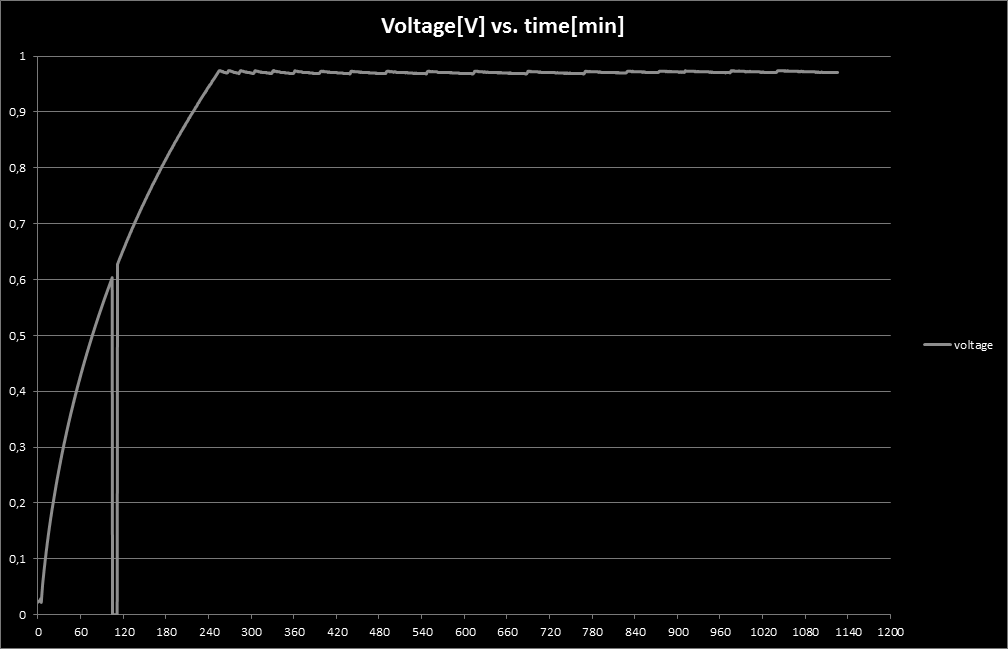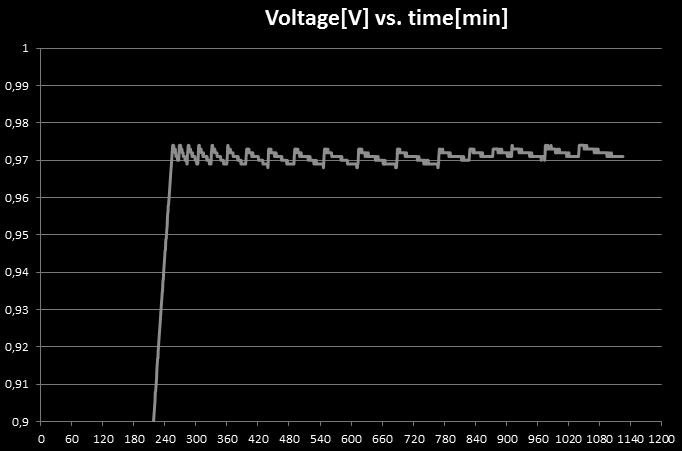I put together two pieces tested separately in previous logs - capacitor bank and charger. I know the charger is able to charge smaller capacitor, as I know the 100F supercap si able to spot weld 0,12mm thick nickel strip to battery.

Everything is powered by single CR2032 cell and voltage on supercap is monitored by logging DMM. I adjusted the 2M7 resistor from this log to get higher value. I did a quick math and inserted 1,2MOhm resistor in place.
When I returned to place, I found out the capacitor isn't much charged, battery is happily at 2,9V, looking at voltage log revealed what went wrong,

Ignore the dropout at roughly 100 minute mark - it was loose probe. The capacitor charged nicely to approximately 0,97V, then it stopped. The change was quite abrupt and voltage didn't fall much since then, so the capacitor was trickle charged, because the charger decided to do so.
In order for the charger to stop charging, the voltage on inverting pin of comparator has to be equal to zero (voltage on non-inverting input). This happens when voltage on the two resistor is divided exactly in ratio of their resistances, so
where Ru is upper resistor in divider (2,7M in my first example) Rb is bottom resistor (1,5M in my first example) Vc is voltage on capacitor and Vr is reference voltage, 1,23V here.
Solving for Ru 1,2M gives me voltage about 0,98V, what seems to be exactly what I measured. To get to around 2,6V, I need to set the resistor to 3,2MOhm, so that 1,2M figure was apparently brain fart. So now I lost 20 hours of time, but the charger seems to work exactly as expected and works per my commands (not my intentions, though).
Notice the voltage during "trickle charging"

Every time the voltage decreased under ~ 0,97V, comparator noticed and charger started charging, action stopped at ~ 0,975V. Capacitor discharged slowly (mostly due to its own leakage), so the frequency of charging events is proportional to the discharge rate. You can see the discharge rate apparently decreased over time, this goes together with datasheet values of discharge specified to be 0,16mA after 72 hours for 50F capacitors, suggesting the value decreases over time. Interestingly enough, I measured value ~ 1,7uA (two orders of magnitude) for both of them at 0,97V after 19 hours from start of charging at room temperature.
Now I'm continuing the charging with the same CR2032 cell and feedback resistor of 3,2MOhm, voltage is around 1,13V at the time of writing this sentence.
 jaromir.sukuba
jaromir.sukuba
Discussions
Become a Hackaday.io Member
Create an account to leave a comment. Already have an account? Log In.